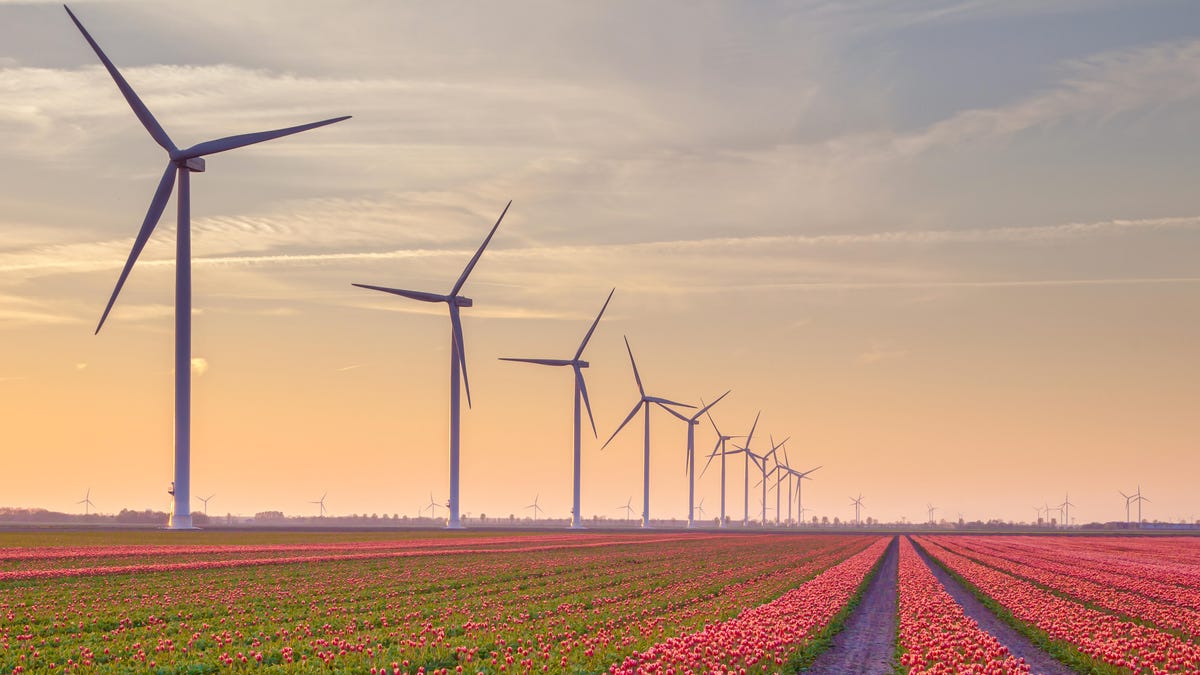Wind Turbine Blades Could Be Recycled Into Gummy Bears Someday

Wind turbines in the Netherlands, among a field of tulips.
What's happening
Scientists propose making wind turbine blades out of a new material that can be recycled into a myriad of common items.
Why it matters
It's difficult and expensive to recycle standard wind turbine blades made of fiberglass, so retired equipment typically ends up in a landfill.
Even wind power -- arguably the most established way to generate eco-friendly energy -- has an Achilles' heel.
Sky-high towers that source power from the wind are topped with enormous turbine blades, and these blades have to be replaced every so often. Thus, a hefty amount of old equipment must be disposed of, and in recent years, experts have debated whether such disposal meets environmentally friendly criteria.
Simply, the worry is whether wind turbine blades are recyclable. If not, perhaps dumping retired blades in landfills sort of negates the system's presumed sustainability in the first place. These blades are typically made of fiberglass, a material really hard to cut through, transport and repurpose into other things.
Though some experts have had success recycling the energy-catching tool, such as US startup Global Fiberglass Solutions, which used them to create 3D-printing feedstock, statistics show that most of the time, the artifacts are just added to piles of trash that emanate harmful gasses into the atmosphere and encroach on natural wildlife habitats. Why? It's ultimately cheaper.
However, scientists from Michigan State University, on Monday, offered their blueprints of an innovative way to address this issue. They developed a new form of wind turbine material that combines glass fibers with both plant-derived and synthetic polymers, which refer to long chains of molecules. The mixture is called a composite resin, and its hype lies in the fact that it can be recycled a lot more easily than pure fiberglass can.
Oh, and here's the best part: It can also be turned into delicious gummy bears.
"The beauty of our resin system is that at the end of its use cycle, we can dissolve it, and that releases it from whatever matrix it's in so that it can be used over and over again in an infinite loop," John Dorgan, a chemical engineer from MSU, who will be presenting the team's work at the fall meeting of the American Chemical Society, said in a press release. "That's the goal of the circular economy."
Turning turbines into treats
Basically, the team's novel resin can be separated into its constituent parts when its job as a wind turbine structure is complete. Crucially, this means the hard-to-handle glass fiber bits can be removed. Then, the resulting goop can be recast into new wind turbines, as well as a wide variety of other materials. And I mean wide.
It merely depends on which of the mixture's constituents you decide to pull out and manipulate.
When the researchers digested the resin in an alkaline solution, for instance, they received an acrylic substance that can be used in making windows and car tail lights. Raise the temperature during digestion and that yields a super-absorbent polymer instead, one often called on when making diapers.
This resin can also reincarnate as household countertops when melded with various minerals. "We've recently made a bathroom sink with the cultured stone, so we know it works," Dorgan said. And the dissolved material can be combined with plastics too, which gives rise to more luxe items, like laptop covers and power tools.
"We recovered food-grade potassium lactate and used it to make gummy bear candies, which I ate," Dorgan said. Not a Haribo fan? This chemical can also be made into sports drinks akin to Gatorade.
A composite resin suitable for making wind turbine blades could be recycled into a variety of products, including gummy bears like these.
And if you're grossed out by the idea of eating a gummy version or a fruity beverage concoction built from an old wind turbine, Dorgan emphasizes that "a carbon atom derived from a plant, like corn or grass, is no different from a carbon atom that came from a fossil fuel ... it's all part of the global carbon cycle, and we've shown that we can go from biomass in the field to durable plastic materials and back to foodstuffs."
However, it's also important to note that so far, the team has manufactured only a prototype of its invention. And to get from prototype to final product, Dorgan explained, there's a bit of a limitation: "There's not enough of the bioplastic that we're using to satisfy this market, so there needs to be considerable production volume brought online if we're going to actually start making wind turbines out of these materials."
But should that hurdle be cleared, we may enter an era where our Macbook cases, iPhone charging cables, sturdy kitchenware and even gelatinous snacks are laced with the remnants of a veteran blade that once lived among the clouds.

